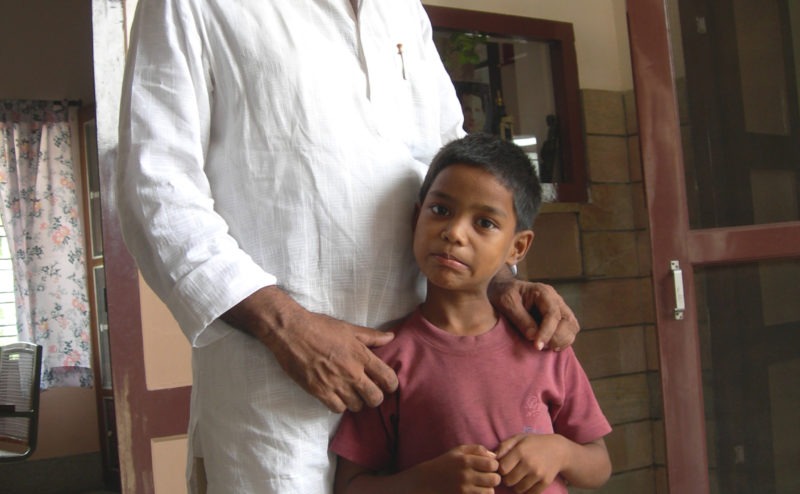
Foreign Filming
Written by Nikki Chase | Posted by: Anonymous
Rooted at Navajeevan Bala Bhavan, a homeless shelter run by Father Thomas Koshy, a Catholic Salesian priest, the film examines the pasts that brought street children to the shelter and attempts to uncover the futures that may lay before them.
Pullapilly grew up taking trips with her professor father, who led university students on semesters abroad through India and Europe. “He would arrange meetings with prime ministers and dignitaries,” she said. “There would be cameras everywhere.” She was inspired to travel and tell stories through a visual medium.
Pullapilly traveled to Vijayawada, India with her two partners at Dungby Productions, Aron Gaudet and Dan Ferrigan. The three met while working in television news in Michigan. They moved to Boston to be closer to another story they’ve been obsessed with since 2004 — about a community in Maine that has vowed to greet every US soldier as he/she leaves for and returns from Iraq and Afghanistan. They just started post production on what they anticipate will be a feature-length documentary.
Meanwhile, they are also entering post production on another project, documenting the first-ever filmed testimony of Palestinian refugees living in Jordan.
Nikki Chase: What brought you to India for India: A New Life?
Gita Pullapilly: My brother was a volunteer at an orphanage in Vijayawada and would tell me all these interesting stories about rescuing street children. My team was planning to go to India — that was in 2005. When we got to the center we talked to this priest who worked with children. We just wanted to see what the story was, so we started shooting. There are a lot of stories about people who do what he does, but it was his personality and charisma — the way he talked to the children — they just wanted to open up to him.
NC: Were there any difficulties in shooting abroad?
Pullapilly: It’s hard because, when you go into various countries, you don’t know how you’re going to be received by the government, and then there are language barriers. We had to have a translator help us the whole time we were there. Plus, you don’t know the land very well, no matter how much you plan. You have to let things go and let it take you in the direction it wants to take you. You have to let the story play out because that might just be a better ending to the story. We learned early on to be very open about the direction and focus.
NC: So many of these children have such dark pasts. How did you get them to share their stories on camera?

Gita and Hasina.
[Click to enlarge]
Pullapilly: That was extremely difficult. When we first went to Vijayawada, we knew we wanted to find a few street children to connect to and share their stories. With Hasina, we really didn’t know much about her story. We knew she was HIV positive and a little older than most of the kids. She just had something about her and we said, “Let’s try it, let’s hear her story.” I first asked her a little about her background. She was very shy and didn’t open up… I just heard bits and pieces. I kept asking similar questions, a little bit differently. Finally I just said, “I want her whole entire story.” But her big thing was, “Is this going to help me?”
NC: Do you find it easier to get children, rather than adults, to open up?
Pullapilly: Typically children are more trusting and less skeptical than adults, but they also generally have a tougher time dealing with and talking about a traumatic experience. So it’s a balancing act. The camera and the excitement of being on TV helps get them to talk to you and trust you, but then you have to be aware of just how fragile they are and find the best way to approach a sensitive subject. If done right, it can be very powerful. Sometimes, we would just sit there with the camera rolling and just capture their expressions — that in itself would say so much.
NC: At one point in the segment, one of the children goes missing and you help search for her. None of that is shown on camera, but what was it like to be a part of that?
Pullapilly: It was really difficult because as a journalist, one of the rules was not to get too connected to your characters, but as a documentary filmmaker, I can’t help it. Even though Vijayawada is a large city, street kids know street kids: where they’re hiding, what their story is. When we started asking people, the street team was sent out and people kept saying nobody knows. I kept thinking, that’s impossible, this is India. Everybody knows everything… We can’t make assumptions about what happened; we just have to hope that she’s living happily somewhere.
NC: According to the comments left online, people all over the world have accessed the segment. Do you attribute that to its online access?
Pullapilly: I definitely think part of it is that Frontline World has a great network. It helped to get it on Frontline World and online because it allowed people to see our piece. If it was submitted to some film festival people would see it, but it wouldn’t necessarily be viewed all over the world.
NC: When you hear such emotional stories, like those of these children, it is hard for you to remain journalistically neutral?
Pullapilly: We know the government in India is making some progress in order to help street children. At the same time, you do a social issue piece because you want to highlight a social issue. You know that they’re just innocent kids that never had the opportunity to have a loving environment to go home to. It makes something like this much easier to do because if someone saw this story, it might save the life of one child in India.
The film can be viewed on the Frontline World website. Pullapilly is hoping it gets picked up for domestic and/or international broadcast when the new television season begins.











